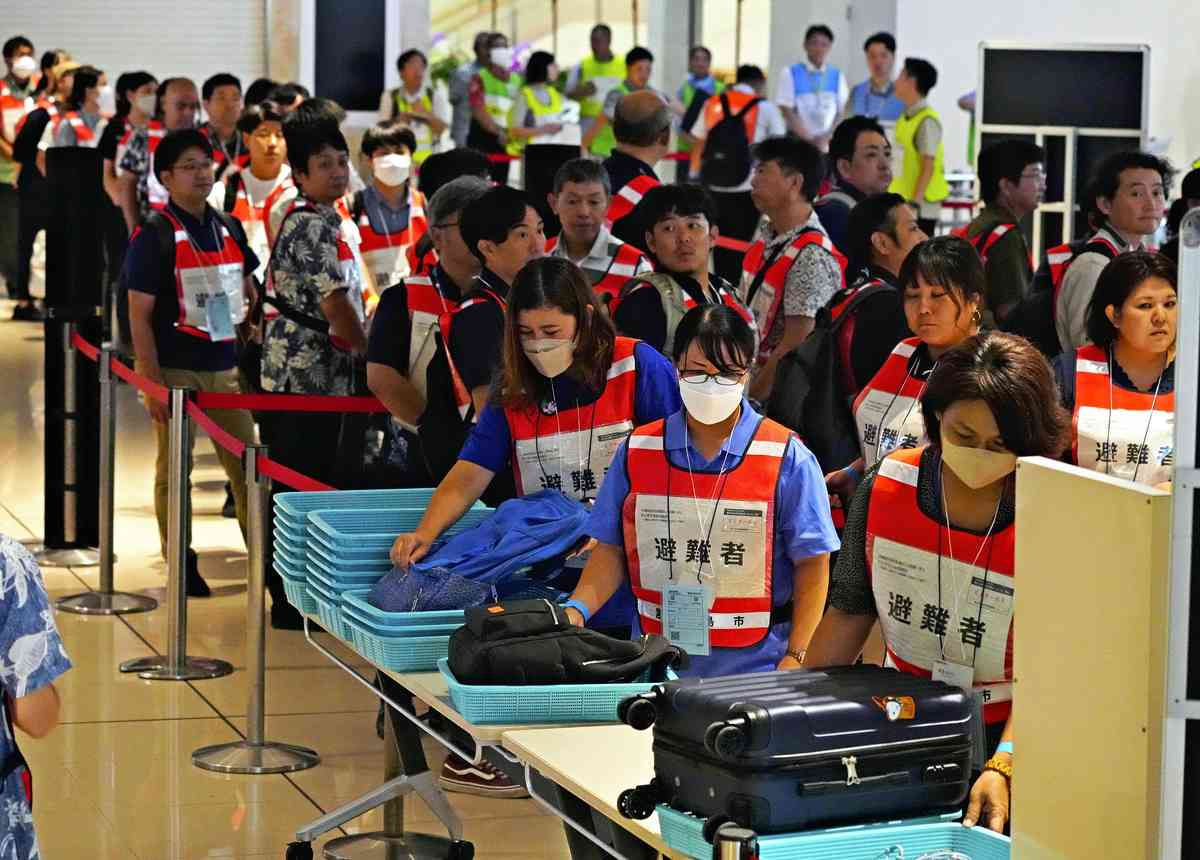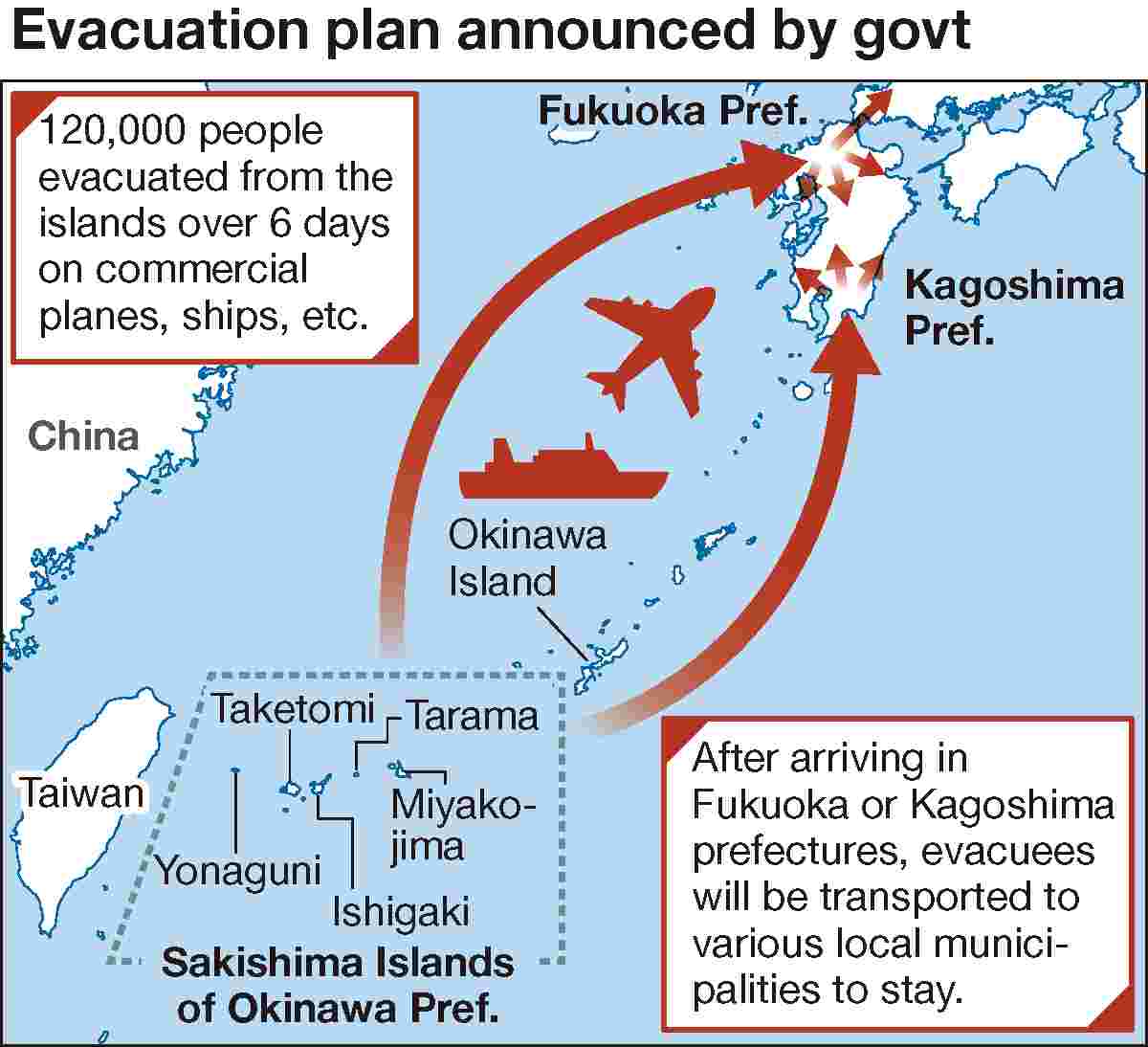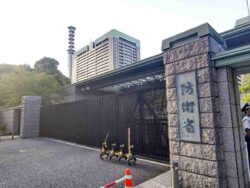Sakishima Islands Evacuation Plan Not Yet Perfected; Prospect of Taiwan Contingency Said to Be Growing

Evacuation procedures are rehearsed in a drill at New Ishigaki Airport in the Sakishima Islands in September 2024.
20:00 JST, March 28, 2025
The government’s plan to evacuate about 120,000 people from several southwestern islands in the event of a contingency in nearby Taiwan faces an array of daunting challenges, including limited accommodation capacity, limited financial assistance for accommodations and a shortage of bus drivers to transport evacuees to their accommodation after they have been flown to other parts of the country.
The plan announced Thursday would see residents from the Sakishima Islands of Okinawa Prefecture evacuated to Kyushu’s seven prefectures and Yamaguchi Prefecture in the event of an emergency in Taiwan. Given that some observers estimate China will be prepared to invade Taiwan as soon as 2027, Japan’s public and private sectors have many tasks to address to ensure they can smoothly work together to conduct a mass evacuation of island residents.
Yonaguni Island, Japan’s westernmost point, is one of the Sakishima Islands. Fears about a confrontation between Beijing and Taipei are mounting on Yonaguni, which is just 111 kilometers from Taiwan and would not be able to casually ignore such a contingency should it erupt.
Kenichi Itokazu, mayor of Yonaguni, has welcomed the government taking the initiative in developing a plan to evacuate the island’s residents. “Diplomatic efforts to prevent any such contingency from occurring are the most important step, but we must be fully prepared, just in case,” Itokazu said.
Chief Cabinet Secretary Yoshimasa Hayashi insisted the government’s position is that the plan was not drawn up on the assumption that any particular emergency could happen. However, the presence of China, which has been ratcheting up pressure on Taiwan, is certainly at the forefront of government officials’ minds.
Based on the initial plan, the government will complete the final plan by fiscal 2026 and conduct training drills. Many observers believe this schedule was set due to widespread awareness of the risk of a Taiwan contingency occurring in 2027.
Doubts and discontent
Efforts to keep residents of island communities together are one defining feature of the plan. The government has paired five Sakishima cities, towns and villages that will be evacuated with locations in Kyushu and Yamaguchi Prefecture where their residents will take shelter. Residents will be carefully assigned to hotels and ryokan inns based on the district from which they came.

However, doubts about and discontent with this plan have emerged from some of the facilities tapped to accommodate evacuees.
The plan calls for Kumamoto Prefecture to transport Miyakojima Island evacuees who arrive at Kagoshima Airport in neighboring Kagoshima Prefecture to Kumamoto City and four other cities and towns by chartered bus. The Kumamoto prefectural bus association is skeptical of this proposal. “Our drivers are getting older and the driver shortage is becoming increasingly acute,” an association official told The Yomiuri Shimbun. “I doubt many bus operators would be able to meet such a request.”
Accommodation fees at hotels and inns also could throw a spanner in the works. The upper limit guideline for government financial assistance is set at ¥7,000 per person per night, including meals. About 47,400 residents from the cities of Miyakojima and Ishigaki are slated to be evacuated to Fukuoka Prefecture. However, according to a survey of hotels in the prefecture, the average accommodation fee is ¥12,000 for an overnight stay without meals. These fees reportedly have been rising for reasons such as soaring costs.
“The upper limit cap is out of sync with current reality,” the operator of a hotel in the prefecture grumbled. “Under these circumstances, no hotels will accept these evacuees.”
Furthermore, the potential capacity of the accommodation facilities has been calculated on the premise that all rooms will be available. That assumption likely will need to be closely examined.
Will all residents evacuate?
The revised plan also will need to make provisions for the possibility that the evacuation period becomes prolonged. This will include securing employment and enabling students to attend schools, and assisting more than 7,000 vulnerable people who need special care, such as elderly people and those with disabilities.
There is no penalty for people who refuse to follow a prefectural governor’s instructions to evacuate based on the law concerning the protection of people in armed attack situations if evacuation measures are put in place. The plan’s effectiveness could be called into serious question if many island residents hesitate to leave for reasons such as unease over the locations to which they will evacuate.
"Politics" POPULAR ARTICLE
-

Japan to Support Central Asian Logistics Route That Bypasses Russia, Plan to Be Part of Upcoming Summit in Tokyo
-

Japan to Tighten Screening of Foreigners’ Residential Status by Providing Information of Nonpayment of Taxes
-

Takaichi Cabinet Approval Holds at 72% as Voters Back Aggressive Fiscal Stimulus, Child Benefits
-

Chinese, Russian Bombers Flew Unusual Path by Heading Toward Tokyo; Move Likely Meant to Intimidate Japan
-

Takaichi Meets Many World Leaders at G20 Debut in Johannesburg; Speaks with Heads of Countries Including Italy, U.K., Germany, India
JN ACCESS RANKING
-

Keidanren Chairman Yoshinobu Tsutsui Visits Kashiwazaki-Kariwa Nuclear Power Plant; Inspects New Emergency Safety System
-

Imports of Rare Earths from China Facing Delays, May Be Caused by Deterioration of Japan-China Relations
-

University of Tokyo Professor Discusses Japanese Economic Security in Interview Ahead of Forum
-

Japan Pulls out of Vietnam Nuclear Project, Complicating Hanoi’s Power Plans
-

Govt Aims to Expand NISA Program Lineup, Abolish Age Restriction























